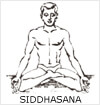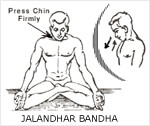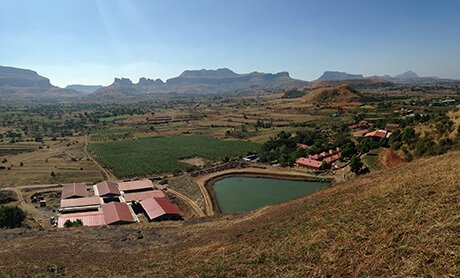It is difficult to explain why this bandh is known as Jalandhar Bandh. However, one may guess that Rishi Jalandhar might have defined the act of this bandh for the first time, and the same was named after him. (In Yoga, sometimes the actions are known by the name of the Rishis, such as Matsyendrasan, Gorakshasan etc.)
If we try to trace the meaning of the word Jalandhar, "Jal" means "Net", in this case, net of Nadis (energy channels) and the word "Dhar" means to stop or to hold the flow of the fluid (Amrut), flowing through the nadis. However, let us understand the action behind this bandh instead of discussing its name or origin.

This bandh can be achieved without getting into any asana pose. But generally, it is studied in Padmasan or any other asana specified for Dhyana Process. Padmasan or Siddhasan are considered as the best positions to practise this bandh.

The neck is to be bent a little for achieving this bandh. But it should not be bent much. It is to be pressed onto the depression just as a spring is pressed with a little force. The release of the force brings the spring back into normal position. The same principle is to be applied in this bandh. Since all the muscles of the neck and the throat are contracted totally, a force is exerted onto the seven paths in the throat. The presence of the force interferes with the breathing process. Hence, this bandh is to be attained after Pooraka and is to be released before Rechaka. The bandh is necessary in Kumbhaka.
Nowhere, the effects of this bandh on the body have been clearly defined. However, effects can be enumerated on the basis of experiments carried out at Kaivalyadham, Lonavala and other observations while teaching and studying this bandh.
Due to the particular action of the neck required to achieve this bandh, it is pressed forward and the spinal cord gets a little bit lifted upwards. The force of this action is felt on the spinal cord. Spinal cord has the utmost importance in the control of the body. With this force, the circulation of blood increases thereby increasing the efficiency of the spinal cord.
The bandh also affects "Vidyan Nadi" which passes through the neck. It is the only blood vessel passing below the neck. It is divided into two parts, which move towards the brain. These are known as Carotid Arteries. These arteries pass from both the sides of the neck to the brain. The beats of the heart can be easily felt if the neck is bent backwards, the pulse is felt on both the sides below the jaw. The area where the blood vessel is divided into two parts is a little bit flat and is known as Carotid Sinus. The wall covering Carotid Sinus is thin and can easily get affected by inner or outside pressure. The nerve passing from here to the brain is known as Carotid Nerve. It goes high up into the skull and then down into the brain. This nerve is related to internal carotid, external carotid and carotid sinus. The pressure exerted on this nerve is transmitted to the brain. The pressure can be exerted from outside too. This process is attempted in the Jalandhar Bandh. Due to the peculiar position of the neck, the pressure is exerted on carotid sinus and the nerves are activated to send a signal to the brain. The brain activates its machinery to lower the blood pressure, so that the muscles of the heart start functioning slowly. The heart beats are reduced. The reason why this happens is that the position of the bandh lessens the blood supply to the carotid artery. The reduction in the blood supply to the brain slows down the body activities and the practitioner can observe the complete stillness of body and mind. But to achieve this position, the bandh has to be practised for a number of years. After putting in enough practice, the yogasadhaka can achieve such elated state of mind wherein he can forget the outside world and even the awareness of his own body. Most of the functions of the body are stopped and the sadhaka can progress towards samadhi. However, with even a little bit of study and practice of this bandh, sadhaka can achieve calm and quiet mind devoid of any thoughts and the nearly lifeless body. The state is pleasurable.
The messages are passed on from carotid sinus to that centre in the brain which regulates the blood pressure. The pressure on the carotid sinus is transmitted to the brain in the form of messages and accordingly the blood pressure is reduced. This is the plan of the nature to reduce the increased blood pressure. In pranayam, there is a possibility of increasing the blood pressure while performing Kumbhaka. Hence, achieving Jalandhar Bandh before Kumbhaka automatically results in controlling the bloodpressure. This is a major benefit of Jalandhar Bandh.
There is another important benefit of this bandh. The bandh is advised in Pranayam after Pooraka. Kumbhaka is observed after Pooraka. At the time of observing Kumbhaka , the increased pressure on the inhaled air, results in air trying to find out an escape route. Since the usual path of escape i e the nostrils are closed, the air tries to enter eustachian tube and finds a way behind the ear drums. The increased pressure on the eardrums is not advisable and can cause a lot of complaints. However, the position of the pressed neck in Jalandhar Bandh stops this inhaled air from entering into these routes and the eardrums are saved from the ill effects.
This bandh is to be observed after Pooraka and before Kumbhaka. After Kumbhka, the bandh is to be released before practising Rechaka. Hence, the duration of Kumbhaka is the duration for this bandh too. Instead of practising this bandh independently, it is to be practised while practising Pranayam.
The bandh is not to be practised by persons suffering from breath related problems or high or low bloodpressure, unless advised by the experts in the field. During Pranayam, the bandh is to be observed after Pooraka. Rechaka is to be practised after Kumbhaka, after releasing the bandh. Rechaka should not be observed while being in this bandh.
The bandh has been described in Hathapradeepika in the third chapter as under :
Meaning -
The chin is to be pressed on the chest after contracting the throat. This bandh eliminates old age and death. The contracted veins in the throat ensure that the liquid from the skies is received here. Hence, the bandh has been appropriately known as Jalandhar Bandh, which means that it destroys any pain in the throat.
Gherandsamhita has also described the bandh as under :
Meaning -
The chin is to be pressed onto the heart after contracting the throat. This Jalandhar Bandh supports sixteen types of bandhas and destroys death.
Meaning -
Jalandhar Bandh is Swayamsiddha and the sadhaka who practises this bandh for six months will, no doubt, achieve siddha status.
In both the texts, the description as well as the effects of the bandh is more or less the same. Both the texts have assured that the bandh causes destruction of old age and death. Observing this bandh gives peace and calmness to both, the heart and the mind. This in turn increases the lifetime of the sadhaka.
| COURSE | Venue |
Phone - +91-9822770727
E-mail - yoga@yogapoint.com or yogapoint108@gmail.com

Yoga Vidya Dham, Kaivalya Nagari,
College Road, Nashik - 422005.
Maharashtra, India.
Phone - +91-9822770727 (for courses in ENGLISH)
+91-253-2318090 (For courses, in HINDI or MARATHI)
(Please call during 9.00 AM to 5 PM Indian Time)
E-mail - yoga@yogapoint.co or yogapoint108@gmail.com
Village Talwade, Trimbak, Nasik
Maharashtra,India.
Phone - +91-9822770727
E-mail - yoga@yogapoint.com or yogapoint108@gmail.com
